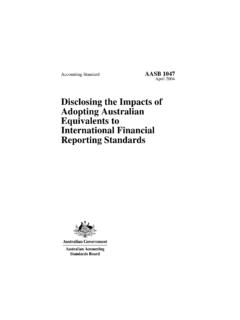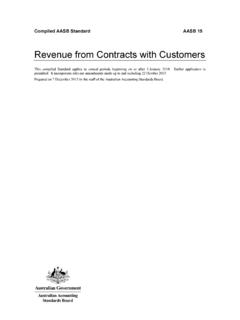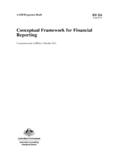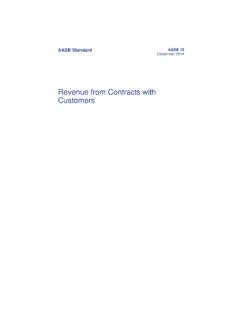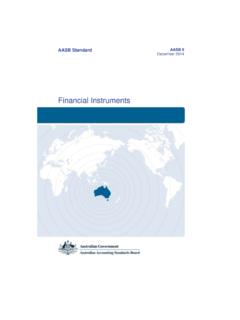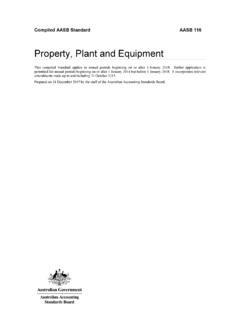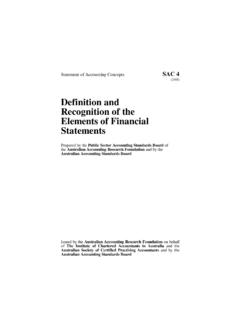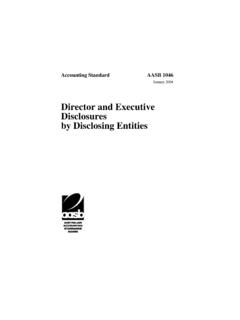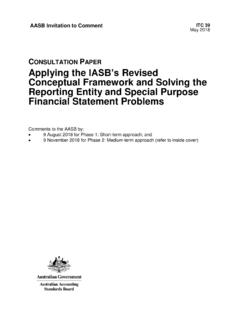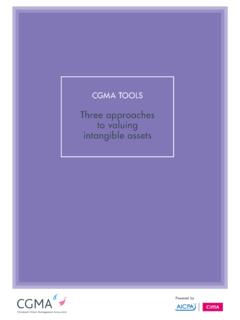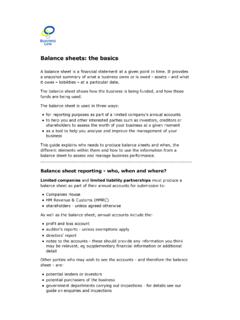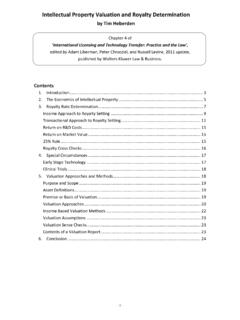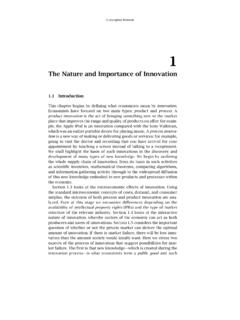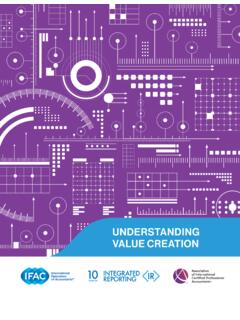Transcription of Leases - Australian Accounting Standards Board
1 AASB Standard AASB 16 February 2016 Leases Federal Register of Legislative Instruments F2016L00233 AASB 16 2 COPYRIGHT Obtaining a copy of this Accounting Standard This Standard is available on the AASB website: Australian Accounting Standards Board PO Box 204 Collins Street West Victoria 8007 AUSTRALIA Phone: (03) 9617 7637 E-mail: Website: Other enquiries Phone: (03) 9617 7600 E-mail: COPYRIGHT Commonwealth of Australia 2016 This AASB Standard contains IFRS Foundation copyright material. Reproduction within Australia in unaltered form (retaining this notice) is permitted for personal and non-commercial use subject to the inclusion of an acknowledgment of the source.
2 Requests and enquiries concerning reproduction and rights for commercial purposes within Australia should be addressed to The Director of Finance and Administration, Australian Accounting Standards Board , PO Box 204, Collins Street West, Victoria 8007. All existing rights in this material are reserved outside Australia. Reproduction outside Australia in unaltered form (retaining this notice) is permitted for personal and non-commercial use only. Further information and requests for authorisation to reproduce for commercial purposes outside Australia should be addressed to the IFRS Foundation at ISSN 1036-4803 Federal Register of Legislative Instruments F2016L00233 AASB 16 3 CONTENTS Contents PREFACE COMPARISON WITH IFRS 16 Accounting STANDARD AASB 16 Leases from paragraph OBJECTIVE 1 SCOPE 3 RECOGNITION EXEMPTIONS 5 IDENTIFYING A lease 9 Separating components of a contract 12 Lessee 13 Lessor 17 lease TERM 18 LESSEE Recognition 22 Measurement Initial measurement Initial measurement of the
3 Right-of-use asset 23 Initial measurement of the lease liability 26 Subsequent measurement Subsequent measurement of the right-of-use asset 29 Subsequent measurement of the lease liability 36 lease modifications 44 Presentation 47 Disclosure 51 LESSOR Classification of Leases 61 Finance Leases Recognition and measurement 67 Initial measurement 68 Subsequent measurement 75 Operating Leases Recognition and measurement 81 lease modifications 87 Presentation 88 Disclosure 89 Finance Leases 93 Operating Leases 95 SALE AND LEASEBACK TRANSACTIONS 98 Assessing whether the transfer of the asset is a sale 99 Transfer of the asset is a sale 100 Transfer of the asset is not a sale 103 COMMENCEMENT OF THE LEGISLATIVE INSTRUMENT APPENDICES A Defined terms Federal Register of Legislative Instruments F2016L00233 AASB 16 4 CONTENTS B Application guidance C Effective date and transition D Amendments to other Standards DELETED IFRS 16 TEXT AVAILABLE ON THE AASB WEBSITE Illustrative examples Basis for Conclusions on IFRS 16 Australian Accounting Standard AASB 16 Leases is set out in paragraphs 1 and Appendices A D.
4 All the paragraphs have equal authority. Paragraphs in bold type state the main principles. Terms defined in Appendix A are in italics the first time they appear in the Standard. AASB 16 is to be read in the context of other Australian Accounting Standards , including AASB 1048 Interpretation of Standards , which identifies the Australian Accounting Interpretations, and AASB 1057 Application of Australian Accounting Standards . In the absence of explicit guidance, AASB 108 Accounting Policies, Changes in Accounting Estimates and Errors provides a basis for selecting and applying Accounting policies.
5 Federal Register of Legislative Instruments F2016L00233 AASB 16 5 PREFACE Preface Introduction The Australian Accounting Standards Board (AASB) develops, issues and maintains Australian Accounting Standards , including Interpretations. The AASB is an Australian Government agency under the Australian Securities and Investments Commission Act 2001. AASB 1057 Application of Australian Accounting Standards identifies the application of Standards to entities and financial statements. AASB 1053 Application of Tiers of Australian Accounting Standards establishes a differential reporting framework consisting of two tiers of reporting requirements for preparing general purpose financial statements.
6 What this Standard requires AASB 16 introduces a single lessee Accounting model and requires a lessee to recognise assets and liabilities for all Leases with a term of more than 12 months, unless the underlying asset is of low value. A lessee is required to recognise a right-of-use asset representing its right to use the underlying leased asset and a lease liability representing its obligations to make lease payments. A lessee measures right-of-use assets similarly to other non-financial assets (such as property, plant and equipment) and lease liabilities similarly to other financial liabilities.
7 As a consequence, a lessee recognises depreciation of the right-of-use asset and interest on the lease liability, and also classifies cash repayments of the lease liability into a principal portion and an interest portion and presents them in the statement of cash flows applying AASB 107 Statement of Cash Flows. Assets and liabilities arising from a lease are initially measured on a present value basis. The measurement includes non-cancellable lease payments (including inflation-linked payments), and also includes payments to be made in optional periods if the lessee is reasonably certain to exercise an option to extend the lease , or not to exercise an option to terminate the lease .
8 AASB 16 contains disclosure requirements for lessees. Lessees will need to apply judgement in deciding upon the information to disclose to meet the objective of providing a basis for users of financial statements to assess the effect that Leases have on the financial position, financial performance and cash flows of the lessee. AASB 16 substantially carries forward the lessor Accounting requirements in AASB 117 Leases . Accordingly, a lessor continues to classify its Leases as operating Leases or finance Leases , and to account for those two types of Leases differently.
9 AASB 16 also requires enhanced disclosures to be provided by lessors that will improve information disclosed about a lessor s risk exposure, particularly to residual value risk. Application date This Standard is applicable to annual reporting periods beginning on or after 1 January 2019 (see paragraph C1). Earlier application is permitted for entities that apply AASB 15 Revenue from Contracts with Customers at or before the date of initial application of this Standard. Why we have issued this Standard Leasing is an important activity for many entities.
10 It is a means of gaining access to assets, of obtaining finance and of reducing an entity s exposure to the risks of asset ownership. The prevalence of leasing means that it is important that users of financial statements have a complete and understandable picture of an entity s leasing activities. The previous Accounting model for Leases required lessees and lessors to classify their Leases as either finances Leases or operating Leases and account for those two types of Leases differently. That model was criticised for failing to meet the needs of users of financial statements because it did not always provide a faithful representation of leasing transactions.
